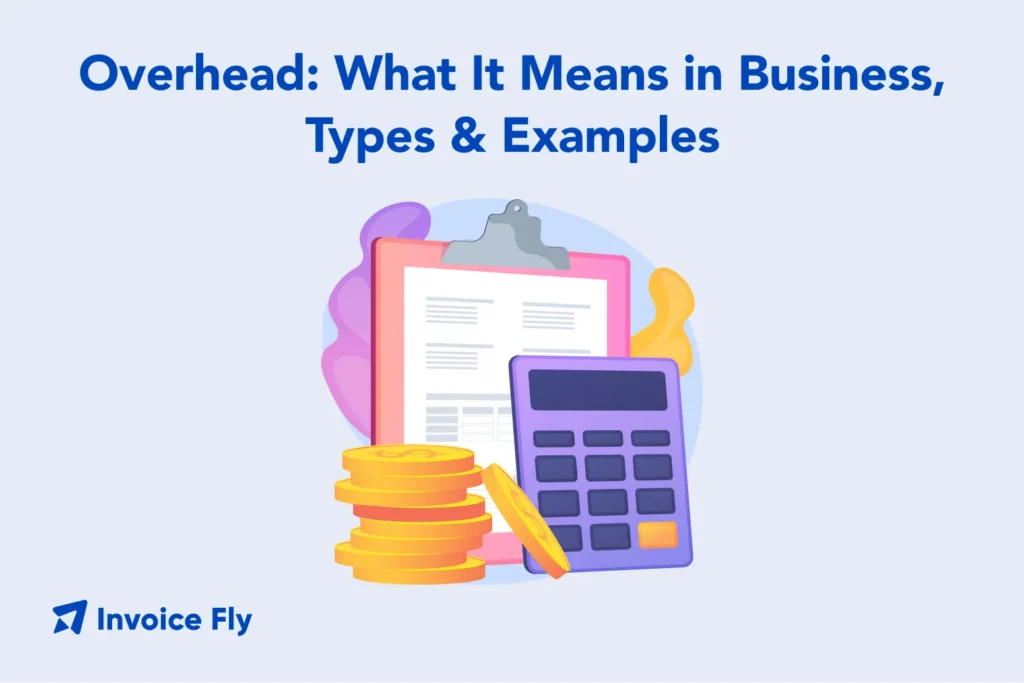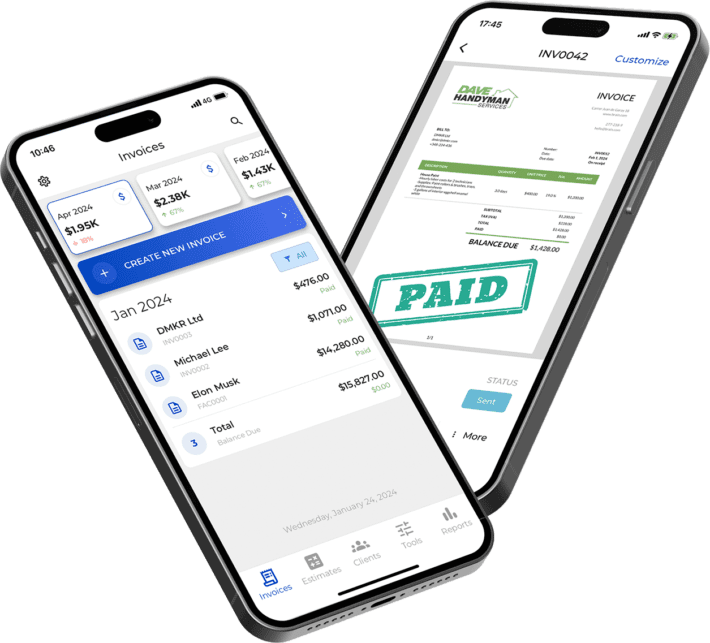Overhead: What It Means in Business, Types & Examples

Table of Contents
If you’ve ever wondered why your profits don’t match your workload, overhead is usually the reason. It’s the silent expense that eats into your earnings — rent, admin time, software subscriptions, utilities — all the things that keep your business running whether or not you’re on a job.
For small and service-based businesses, knowing your overhead cost meaning is essential. It’s not just an accounting concept or a ‘nice-to-know’, it’s the difference between sustainable profits and unpredictable cash flow. According to Harvard Business Review, businesses that manage overhead strategically can maintain healthier profit margins during economic shifts.
In this guide, we’ll explain:
- The meaning of overhead in business and accounting
- Common types of overhead costs
- Examples from real service-based businesses
- How to calculate and reduce overhead without losing quality
What Does “Overhead” Mean in Business?

Simple Definition of Overhead
In everyday language, overhead means the costs your business pays to stay open that don’t directly create revenue. These are sometimes called overhead expenses, or indirect costs, and they include everything from rent to accounting.
So, the meaning of overhead in business is simple:
Overhead = the recurring costs that support your business operations.
The meaning of overhead cost or meaning overhead cost covers ongoing expenses such as utilities, insurance, admin wages, and software. Think of them as the things you must pay even when you’re not completing a job.
For example:
- A plumber’s direct costs are parts and labour.
- Their overhead expenses include their van insurance, office rent, and marketing.
These costs don’t directly produce income, but without them, no work gets done.
Overhead vs. Direct Costs
Direct costs can be linked to a specific job, like materials or subcontractors. Overhead is shared across everything your business does.
For instance, an electrician’s cables and fittings are direct costs. Their internet bill, accounting fees, and liability insurance are overhead.
To manage these properly, check out Bookkeeping for Contractors, which explains how to separate project costs from general business expenses.
Get Started with Invoice Fly’s Software
Invoice Fly is a smart, fast, and easy-to-use invoicing software designed for freelancers, contractors, and small business owners. Create and send invoices, track payments, and manage your business — all in one place.

Why Overhead Matters for Profitability
Ignoring overhead leads to inaccurate pricing. Many small businesses set prices based only on materials and labour, forgetting the hidden costs that affect profit.
Tracking your overhead helps you set realistic rates and protect your margins. You can use Invoice Fly’s free Profit Margin Calculator to see how your overhead impacts your bottom line.
When you understand your overhead meaning in business, you gain control of your pricing and profit.
Types of Overhead Costs

Not every overhead cost behaves the same way. Some are fixed, some vary with activity, and some fall in between.
Fixed Overhead
Fixed costs stay the same each month, no matter how busy you are.
Examples:
- Office rent
- Insurance premiums
- Business licences and permits
- Salaried admin employees
- Software subscriptions
Remember: Even if no jobs come in, these costs remain.
Variable Overhead
Variable overhead changes with your workload.
Examples:
- Fuel and travel
- Utilities
- Hourly admin support
- Commission or bonus payments
- Job-specific advertising
This category is often called variable overhead spending, as it fluctuates with how much you produce or sell.
Semi-Variable Overhead
These costs combine fixed and variable elements. A mobile phone bill or cloud storage plan might have a flat monthly fee plus usage-based charges.
Administrative vs. Manufacturing Overhead
Service-based businesses mostly deal with administrative overhead — marketing, management, and office operations.
Product-based companies also have manufacturing overhead, which includes factory utilities, maintenance, and supervision.
Hidden Overhead
Hidden overhead comes from unpaid admin tasks like answering emails, quoting jobs, or updating spreadsheets. It’s easy to overlook, but these hours still cost money and time.
Overhead in Accounting
The overhead in accounting meaning expands on the basic idea: it’s the total of all indirect costs that must be allocated to products, projects, or departments. These costs appear on your financial statements as operating expenses.
Meaning of Overhead in Accounting
From an accounting point of view, the meaning of overhead in accounting is about how these costs are distributed. Rent, utilities, and admin salaries are absorbed into your job costing or departmental budgets so that every project reflects its true cost.
This process is known as applied overhead: assigning a proportion of your total expenses to each job based on time, labour, or materials.
Overhead Absorption
Overhead absorption means spreading indirect expenses fairly across your work.
For example: If your monthly rent is $1,200 and you complete 12 projects, each project “absorbs” $100 of rent as overhead.
This ensures you recover those indirect costs through your pricing and is an essential step for service businesses.
Overhead Variance and Cost Variance
Overhead variance (or cost variance) happens when your actual overhead differs from your budgeted overhead.
For example, your vehicle maintenance costs might come in $200 higher than expected.
Tracking this variance helps you understand spending trends and budget more accurately. According to Investopedia, businesses that monitor overhead variance regularly avoid cash flow shocks later.
Examples of Overhead Costs
Different businesses face different kinds of overhead. Here are a few practical examples.
Service Business Example

A plumbing company might record:
- Vehicle lease and maintenance
- Liability insurance
- Office supplies and admin salaries
- Marketing, website hosting, and accounting fees
Freelancer Example
A freelance designer might include:
- Laptop and design software
- Internet, subscriptions, and phone bills
- Workspace rent
- Marketing tools like Canva or email platforms
Small Retail or Shop Example
A local store might count:
- Rent and utilities
- Payment processing fees
- Inventory software and wages
- Display equipment maintenance
Each example shows the overhead cost meaning in practice and the ongoing support costs that keep the business operating.
Learn how to factor these into pricing in How to Quote Carpentry Jobs.
How To Calculate Overhead Costs

Calculating your overhead gives you visibility over your true expenses and profit margins.
Step 1: List All Indirect Expenses
Include rent, insurance, admin salaries, marketing, and office utilities — the core overhead expenses meaning in accounting.
Step 2: Separate Fixed and Variable Costs
This helps you identify which costs stay constant and which change with demand.
Step 3: Choose an Allocation Base
Common bases include total labour hours, project count, or direct material costs.
Step 4: Apply the Formula
Overhead Rate = (Total Overhead ÷ Total Direct Costs) × 100
Example: If your overhead totals $5,000 and your direct costs are $20,000, your overhead rate is 25%. That means 25% of your total job cost goes toward overhead.
Check your Assets and Liabilities Guide or Income Statement to confirm these figures are accurate.
Small business owners can track this easily with software like Invoice Fly’s Invoice Maker.
How To Reduce Overhead Without Cutting Quality
Controlling overhead means managing admin smarter.
1. Automate Administrative Tasks
Automation saves hours of manual entry. Use invoicing software or scheduling tools to reduce unpaid admin work.
2. Review and Renegotiate Regularly
Revisit subscriptions, insurance, and suppliers every few months. Prices often increase quietly.
3. Go Digital and Remote
Moving paperwork online cuts printing, storage, and postage costs. Remote or hybrid work also reduces utilities and rent.
4. Outsource Strategically
Hire freelancers or virtual assistants for admin, marketing, or design work instead of full-time employees.
5. Track and Compare Savings
Use Market Research for Small Businesses to find cost-effective alternatives.
Save time and track expenses easily with Invoice Fly’s Estimates App — free to use.
Common Mistakes Businesses Make With Overhead
Even experienced owners make errors that inflate costs or reduce profit.
- Mixing direct and overhead costs. Always separate project materials from general business expenses.
- Ignoring small recurring charges. Subscriptions and licences add up quickly.
- Not tracking absorbed overhead. Failing to allocate overhead properly means you underprice jobs.
- Forgetting to update budgets. Rising insurance and utilities can cause unexpected variance.
- Underquoting. Pricing jobs without overhead means you’re losing profit before you start.
- Skipping reviews. Check overhead monthly, not yearly.
Learn more about accurate costing in Hourly vs Flat Rate Pricing.
Calculate Your Overhead With Confidence
Overhead may sound like an accounting term, but it’s really a reflection of how your business operates. Understanding the meaning of overhead in accounting (from fixed and variable costs to variance and absorption) helps you stay profitable and prepared.When you track overhead consistently, you can forecast growth, price accurately, and protect your profitability. Tools like our Invoice Maker make this simple by tracking expenses and automating invoices so nothing slips through the cracks.
Get Started with Invoice Fly’s Software
Invoice Fly is a smart, fast, and easy-to-use invoicing software designed for freelancers, contractors, and small business owners. Create and send invoices, track payments, and manage your business — all in one place.

FAQs About Overhead
It depends on your business. Service-based companies often spend 20–35% of total costs on overhead.
Divide your total overhead by direct costs or hours worked, then apply that rate to your quotes.
Admin or management salaries count as overhead. Labour directly tied to a job is a direct cost.
In accounting, overhead means the ongoing indirect costs absorbed into your overall business operations, such as rent and insurance.
No. Overhead is money spent to run your business; profit is what remains after covering all costs.
Use automation, track monthly costs, and review supplier contracts regularly to avoid unnecessary spending.
